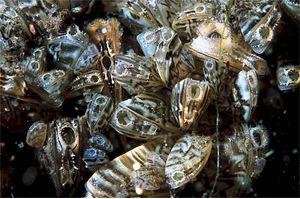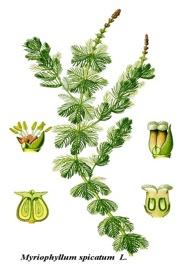Controlling Unwanted Transplants: Zebra Mussels
North America’s industrial, agricultural and municipal water supplies, freshwater shipping, fishing, and shellfish harvesting are under a multimillion-dollar threat from the zebra mussel, first found in the Great Lakes in 1988.
Advertisement
The spread of zebra mussels to other waterways can be prevented by boaters who flush their engines and clean their hulls, machinery and bait-wells thoroughly.
Identifying the Zebra Mussel (Dreissena polymorpha)
- Zebra Mussels look like small clams with yellowish or brownish D-shaped shells, usually with alternating dark and light coloured stripes (hence the name)
- They can be up to two-inches long, but most are less than one inch.
- They inhabit shallow algae-rich water and usually grow in clusters.
- Zebra Mussels are the only freshwater mollusks that can firmly attach themselves to solid objects such as boat hulls, submerged rocks, dock pilings, etc.

Dealing with a Zebra Mussel Infestation
- Drain the entire boat and engine cooling system of water.
- Inspect for infestation.
- Scrape clean all grainy surfaces (potential zebra mussels).
- Wash the boat with hot water above 40oC.
- Air-dry equipment in the sun for at least three days.
- Scrape off any visible mussels.
- Report all suspected growth to the proper provincial environmental authorities.
Eurasian Water Milfoil
This perennial and invasive plant displaces many native water plants by choking off fresh water supplies. In Canada the infestation has been confined to freshwater.
Advertisement

Dealing with Eurasian Water Milfoil Infestation
- Learn how to identify Eurasian water milfoil (Myriophyllum spicatum).
- Eurasian water milfoil stems are slender and can grow up to 3 metres in length. The plants start submerged with the leaves averaging between 15-35mm in length. They are borne as it is called in whorls (a spiral or circular pattern) of four, pinnate (refers to feather-like or multi-divided features arising from both sides of a common axis)
- These plants are monoecious (plants are of a species that bears both sperm and eggs on the same stem)
- There are two species the Eurasian water milfoil and the Northern water milfoil M. sibiricum. These two plants can hybridize (to cause to interbreeding or combine so as to produce hybrids)
- Clear the plant material from the boat, motor, trailer, wet well, and anchor.
Source: www.wikipedia.org